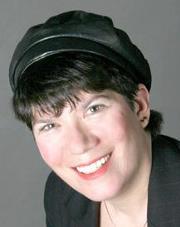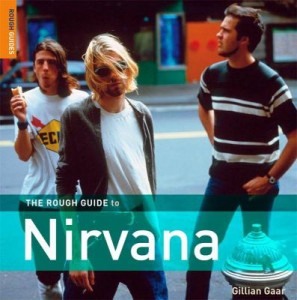(EDITOR’S NOTE: Seattle author and music journalist Gillian Gaar was a writer and columnist for The Rocket for many years and was working on a story about Courtney Love and her band Hole the week Kurt Cobain’s body was found at the Denny Blaine mansion he shared with Love. Here is Gaar’s personal account of the strange experiences of that week in April 1994. It provides a glimpse into the life and work of a Seattle music writer caught up in the biggest music story in Seattle history. The editor of The Rocket at the time was Charles R. Cross (referred to as Charley Cross), who went on to author “Heavier Than Heaven” and other books about Nirvana and Cobain. It has been 20 years since Cobain took his own life. Gaar has since written a number of books on Nirvana, including a new ebook. She also freelances for The Seattle Times.)

By GILLIAN GAAR
I’d been trying to set up an interview with Courtney Love and the other members of Hole for The Rocket magazine since February. After much effort (a lot of it on the part of the editor, Charley Cross) I finally had an interview with her set for April 5 at 4 p.m. I still have the paper with the notes I made for the interview; the phone number, room number (367), etc. I was going to call the hotel where she was staying (the Beverly Hills Peninsula) from my home; I could set up my tape recorder easier there.
Charley called me about noon and said his contacts in L.A. told him that Nirvana was pulling out of Lollapalooza and breaking up. I thought, There goes the interview! As if reading my mind he said, “I’m sure this won’t affect the interview.” I didn’t believe that for a moment, but didn’t say so, just made some noncommittal remark like, “Well, we’ll see.” He asked me to call after the interview was over. We were going to press on April 8, and we never did stories that late.
I wasn’t surprised to call at 4 p.m. and be told the room wasn’t taking calls. But sometimes that happens with a big name and it just means they aren’t ready for you. You leave your name and number and someone calls back in 15, 20 minutes.
And that’s what happened. Eric Erlandson (guitarist in Hole) called. He said Courtney was ill and couldn’t do the interview. I said this was supposed to be a Hole story, not a Courtney one, so could I talk to him? He said yes.
He was in L.A. I know this because at one point he excused himself to answer the door and said they’d brought up a message from the front desk. So he was still in L.A. on the afternoon of April 5. If he went to Seattle that night, he wasn’t in any rush to get off the phone.
He seemed to think the Courtney interview would still happen. He asked me to call and let him know, and gave me his Seattle number, saying it would be easier for him to receive a message there. I didn’t think it might mean he was going to Seattle (which he did at some point that week); certainly it would’ve been easier for him to get it on his answering machine.
I then called Charley and told him what happened. He said if I didn’t hear from Courtney by noon on April 6, the story would be pulled. I was disappointed, but what could I do? If I didn’t have an interview, I could hardly do the story.

I knew I wasn’t going to hear from her. Not because of any foreshadowing of doom. I just felt it wasn’t going to work out.
As it didn’t. I didn’t hear from Courtney, so I called Charley on April 6, and the story was pulled. From that moment on, the cover story was Pavement. Not Hole.
I went into the Rocket on April 7. There was a message from Jim Merlis (a DGC publicist). I didn’t return it, because I knew he was asking about the interview and it hadn’t happened, and I was frustrated about that. I called and left a message for Eric too. He called back and was disappointed the interview hadn’t happened.
On April 8, I did return Jim Merlis’ call. Said the interview hadn’t happened. We didn’t discuss rescheduling it. Then he said he had to go, he had another call coming in. I’ve often wondered if that was a call telling him about Kurt.
We were between receptionists at the Rocket. Thankfully, one of the writers filled in. A new person couldn’t have handled all the incoming calls I don’t think. I started overhearing that people were calling in about radio reports that a body of an unidentified male was found at the Cobain residence. I dismissed it until I got a call from my mother. She heard the report too. That made me take notice. Because the initial reports were going out over rock radio stations. And my mother wasn’t sitting at home listening to rock radio. That meant it had jumped to non-music stations, and so there must be some truth to it.
We were walking around the office as if on eggshells. There had been a lot of turmoil in the Rocket offices. The previous month our managing editor had quit — on the day we heard about Kurt’s OD in Rome. Now, a month later, the ad manager was quitting — on the day they found Kurt’s body. And it was deadline day, which is already a bit hectic.
I kept thinking it could be someone else . . . a friend, perhaps. But then Charley said one of his sources unofficially confirmed it was Kurt. I faxed Jim Merlis telling him how sorry I was and that I was not going to be asking for any comments from him. I was doing some writing for Rolling Stone and was on the phone about that, and I mentioned that Kurt had been found dead. They were stunned and rushed to start covering it. I was asked by Goldmine to do a memorial piece. I did an interview with NPR. Those close to the band weren’t making statements, so people that wanted quotes called The Rocket, and if Charley was on the line they were passed on to me.
Some years ago the ad manager, named Courtney, had dated a medical student, Nikolas Hartshorne. The day’s most surreal moment came when she told me that Nik, now working for the Medical Examiner’s Office, was doing Kurt’s autopsy. Nik had promoted a July 23 1988 show at the Central featuring the Leaving Trains (he was friends with the band) and added Nirvana to the bill at Jonathan Poneman’s suggestion. Now he was doing Kurt’s autopsy. You couldn’t write something like that, I thought, no one would believe it.

At some point it was decided to do some kind of memorial story on Kurt and I got to do it. I went home to write it, as it was too crazy in the office, with the phones ringing all the time. I listened to Bleach as I wrote it. I ferried it back to the office on a floppy disc. It was drizzling, and it may sound corny, but I thought to myself, The city is weeping.
I first wrote about what happened that week in the issue after the Kurt issue a week later, when I wrote the lead review on Hole’s “Live Through This” (for the April 27 issue):
“This was not the story I was originally going to do on Hole. Since February, I’d been trying to set up an interview with the band to support the album’s release, a story I was especially anxious to do after hearing the advance cassette. The first set-back came when Kurt Cobain suffered his overdose in Rome on March 4; obviously, all interview requests were going to be put on hold. But after some time had passed, we tried again, and finally our request was granted. I was to call Courtney Love at the Beverly Hills Peninsula Hotel at 4 p.m. on April 5. I called, but was told Love was unavailable, so I talked to guitarist Eric Erlandson for an hour. He promised to try and get Love to do the interview, for we still had hopes of putting Hole on the cover of our next issue, but when we didn’t hear from Love by noon on April 6, we again put the story on hold.”
On April 8, we weren’t waiting for any call from Courtney for an interview. Of course, it would’ve been more dramatic if that had happened, and I would certainly have included it in my first story about that (not to mention the many times I’ve written about that day since). But it didn’t happen. There was more than enough drama going on; there was no need for any embellishment.
It was awkward being a member of the media that weekend as it was felt that we’d “hounded” Kurt and so were in part responsible for his stress. I was glad that at Sub Pop’s anniversary party at the Crocodile on Saturday night I didn’t have to interview anyone. I hugged Jonathan and I assured him I wouldn’t ask any questions. There was a sense of “Wow. What just happened?” It was nice to be there because you didn’t have to explain to anybody how you felt; everyone knew. Then there was the memorial at the Seattle Center on Sunday; I met up with a Canadian journalist who’d interviewed me there. It was nice hearing the memory DJ Marco Collins read from one of Kurt’s relatives, but of course the most dramatic moment was when they played Courtney’s message; I saw other journalists weeping as it played. And looking out at the sea of kids afterwards was amazing. They redesigned the fountain after that so people couldn’t climb on it as they did that day. I went with another journalist to Linda’s Tavern afterwards.
Looking back, I’d forgotten how traumatic those years were, with a number of high profile deaths. In 1990, Andrew Wood’s drug-related death. In 1991, Jesse Bernstein’s suicide. In 1992, Stefanie Sargent’s drug-related death. In 1993, Mia Zapata’s horrible murder. Culminating in 1994 with Kurt. By the time Kristin Pfaff died of drugs a few months later, you just felt numb.
What was happening at The Rocket at that time has nothing to do with Nirvana. But because the final days for some of the key staff were on these important days, and I’d been caught up in the story in a very minor way through trying to do this interview, and to have it all culminate with Kurt’s death by his own hand, I really had the strong sense of coming to the end of a chapter. This part of the story was over. To go on, you had to turn the page.
